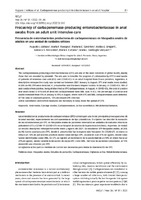Frecuency of carbapenemase-producing enterobacteriaceae in anal swabs from an adult unit intensive care
Date
2021-12-14Author
Vallejos, Augusto Joaquín
Tracogna, María Fernanda
Carol Rey, Mariana Carina
Bregant, Matías Eloy
Fernandez, Mariana Soledad
Cattana, María Emilia
Gariboglio Vázquez, María Lucrecia
Metadata
Show full item recordAbstract
The carbapenemase-producing enterobacteriaceae (CPE) are one of the main concerns of global health, mainly those that are encoded by plasmids. The aim was to describe the progress of colonization by CPE in anal swabs of patients of intensive care unit (ICU) and COVID-ICU in an adult hospital from Chaco province, Argentina. A descriptive retrospective study was carried out between 2021 January to August. 379 anal swabs were studied, in 26% (n=98) CPE were detected. K. pneumoniae was the more frequent isolate. In January, in COVID-ICU, 18% of anal swabs where positive, being all identified as KPC carbapenemase. In August, in COVID-ICU, the total of positive anal swab raised to 81% and all detected carbapenemase were MBL type. In ICU, the percentage of positive anal swabs increased from 14% in January to 49% in August, where both KPC and MBL carbapenemases were detected. Of The total of colonized patients, 15% developed CPE infection. Active surveillance and control measures are necessary to keep down the spread of CPE. Las enterobacterias productoras de carbapenemasas (EPC) constituyen una de las principales preocupaciones de la salud mundial, especialmente las carbapenemasas de tipo plasmídicas. El objetivo fue describir la evolución de las colonizaciones por EPC en hisopados anales de pacientes internados en unidades de cuidados intensivos polivalente (UTI) y COVID-19 (COVID-UTI) en un hospital de adultos de la provincia del Chaco, Argentina. Se realizó un estudio descriptivo retrospectivo entre enero y agosto del 2021. Se estudiaron 379 hisopados anales, el 26% (n=98) fueron positivos para EPC, donde K. pneumoniae fue la especie más frecuente. En COVID-UTI, en enero se obtuvo un 18% de portaciones positivas siendo todas del tipo KPC, escalando a un 81% en agosto, donde todas fueron identificadas como MBL. En UTI, se registró un incremento de la positividad de un 14% en enero hasta un 49% en agosto, siendo variable la detección de cepas KPC como MBL. Del total de pacientes colonizados, el 15% desarrolló una infección por EPC. La vigilancia activa junto a medidas de control son necesarias para limitar la diseminación de EPC.
Collections
The following license files are associated with this item:



